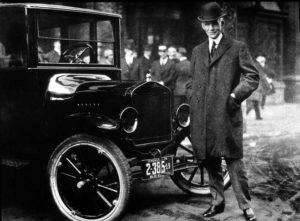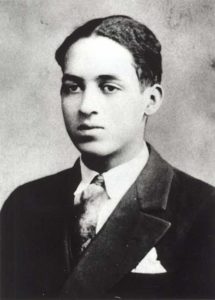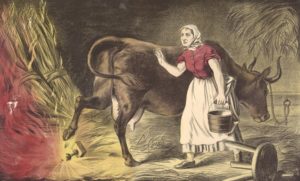October 1 — October 15, 2019
History Matters
Showing our children that their past
is prelude to their future
 On October 1, 1908 Henry Ford’s Model T automobile went on sale. Nicknamed the “Tin Lizzy,” it was considered to be one of the most influential inventions of the 20th Century. And, Ford’s use of assembly-lines to mass produce them made the Model T’s price accessible to the average customer. The American industrial revolution had begun.
On October 1, 1908 Henry Ford’s Model T automobile went on sale. Nicknamed the “Tin Lizzy,” it was considered to be one of the most influential inventions of the 20th Century. And, Ford’s use of assembly-lines to mass produce them made the Model T’s price accessible to the average customer. The American industrial revolution had begun.
For more information about Ford and the importance of his inventions to American history, the Grateful American Book Prize recommends “I Invented the Modern Age: The Rise of Henry Ford” by Richard Snow.
****

Thurgood Marshall was sworn in as the first African American associate justice of the U.S. Supreme Court on October 2, 1967. His career-encompassing crusade to abolish prejudicial laws that restricted rights based on race earned him the moniker, “Mr. Civil Rights.” In the years prior to his appointment, Marshall argued 32 cases before the Court; three are considered “landmark” victories.
In 1944 he argued, successfully, on behalf of the plaintiffs in Smith v. Allwright to overturn a Texas law which allowed the Democratic Party to limit primary voters based on race; four years later, he took the lead in Shelley v. Kramer, and the Court voted to strike down racially circumscribed housing covenants. And, in 1954, he stood before the justices, bucked Brown v. Board of Education, and achieved a ruling that declared segregation in public facilities and schools to be unconstitutional.
The Grateful American Prize recommends “Young Thurgood: The Making of a Supreme Court Justice” by Larry S. Gibson.
****

Legend has it was Mrs. O’Leary’s cow started the Great Fire of Chicago on October 8, 1871. But the fact is that while it likely began in the O’Leary barn downtown, the Smithsonian reports that a board of inquiry could not confirm it. When the smoke cleared, 300 residents had died, approximately 90,000 were left homeless, and nearly 17,500 edifices were burned to the ground. A great “great rebuilding” followed, using innovative construction methods to hedge against the possibility of a similar, future conflagration.
The reconstruction created a new kind of city center. For more information, read “The Great Fire” by Jim Murphy.
****

The U.S Navy celebrates its 244th birthday on October 13, 2019. The American Revolution began in April of 1775, and the Continental Congress established the seafaring branch of America’s armed forces six months later. The purpose was to disrupt British supply lines by purchasing a fleet of small merchant vessels and arming them to intercept British vessels carrying munitions and stores. Just as the Continental Army produced its own heroes, so did the newborn Continental Navy. Notable among them was John Paul Jones, who did not hesitate to enlist soon after the Revolution began with the rank of Senior Lieutenant. By 1779, having already distinguished himself in battle, he was given command of the Bon Homme Richard, a converted French merchant ship. In a famous sea battle with the more powerful British battleship, HMS Serapis, Jones rammed it, effectively attaching the Bon Homme Richard to the Serapis. During the skirmish, the British commander is said to have asked Jones if he was ready to surrender, to which he supposedly responded: “I have not yet begun to fight.” The close quarters in which the battle was fought gave Jones’s crew the opportunity to use grenades to overpower the British ship.
The Grateful American Book Prize recommends “John Paul Jones: Sailor, Hero, Father of the American Navy” by Evan Thomas.
History Matters is a biweekly feature courtesy of The Grateful American Book Prize.




